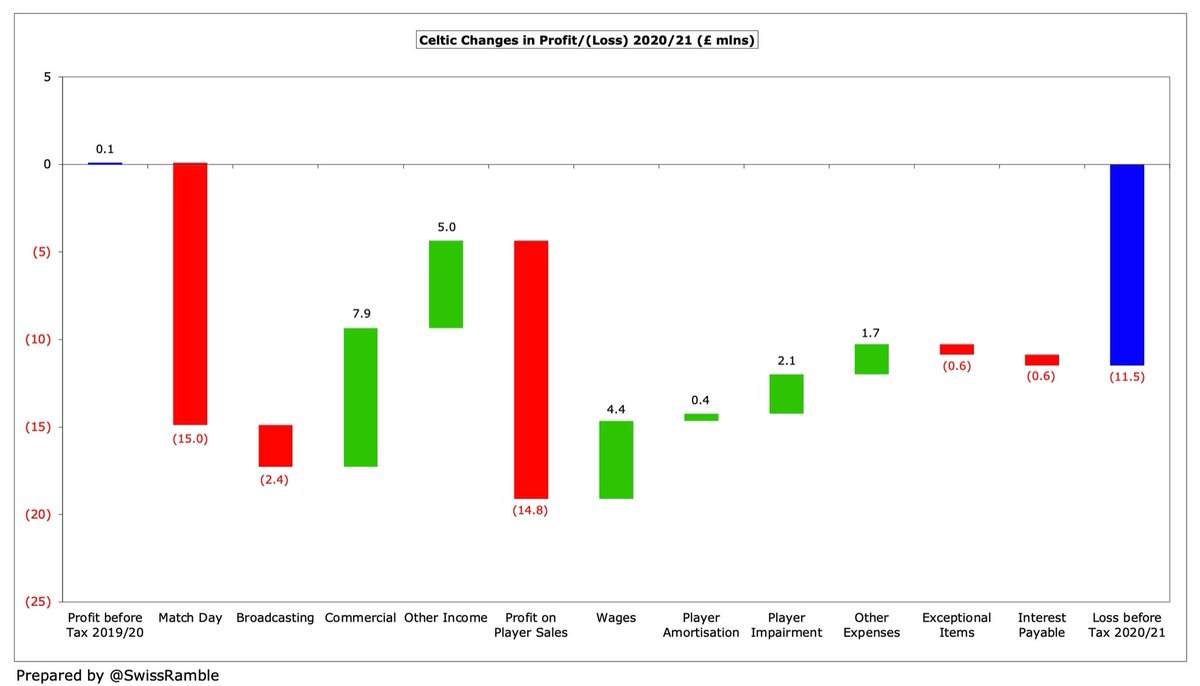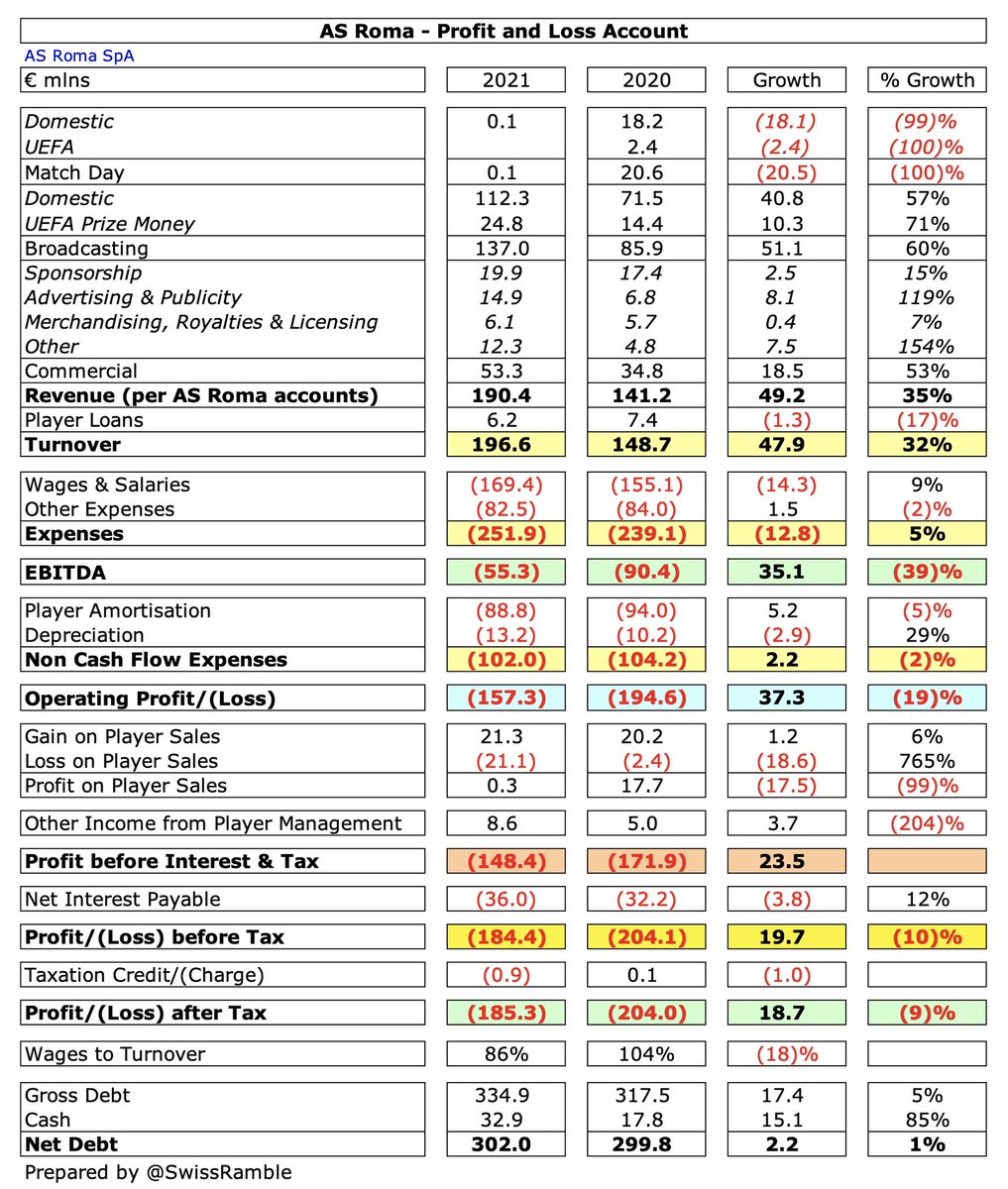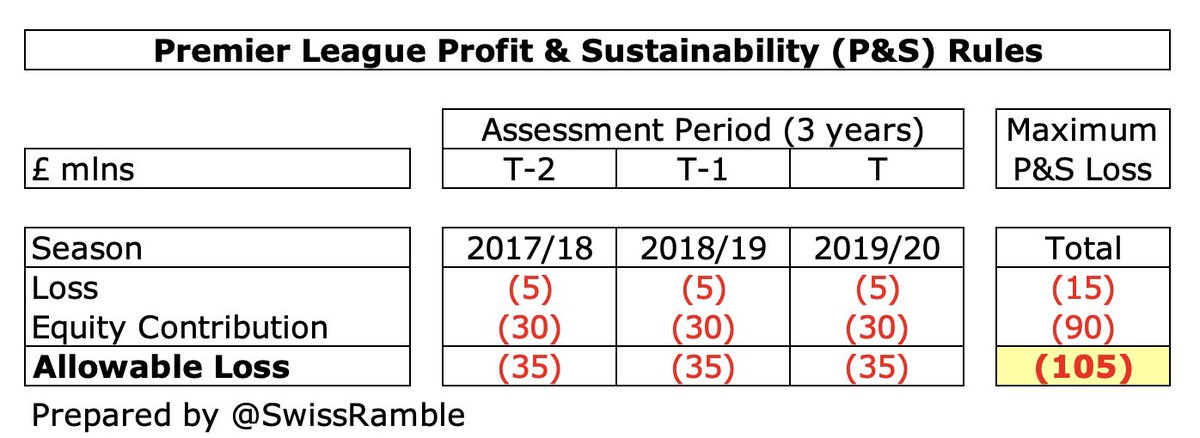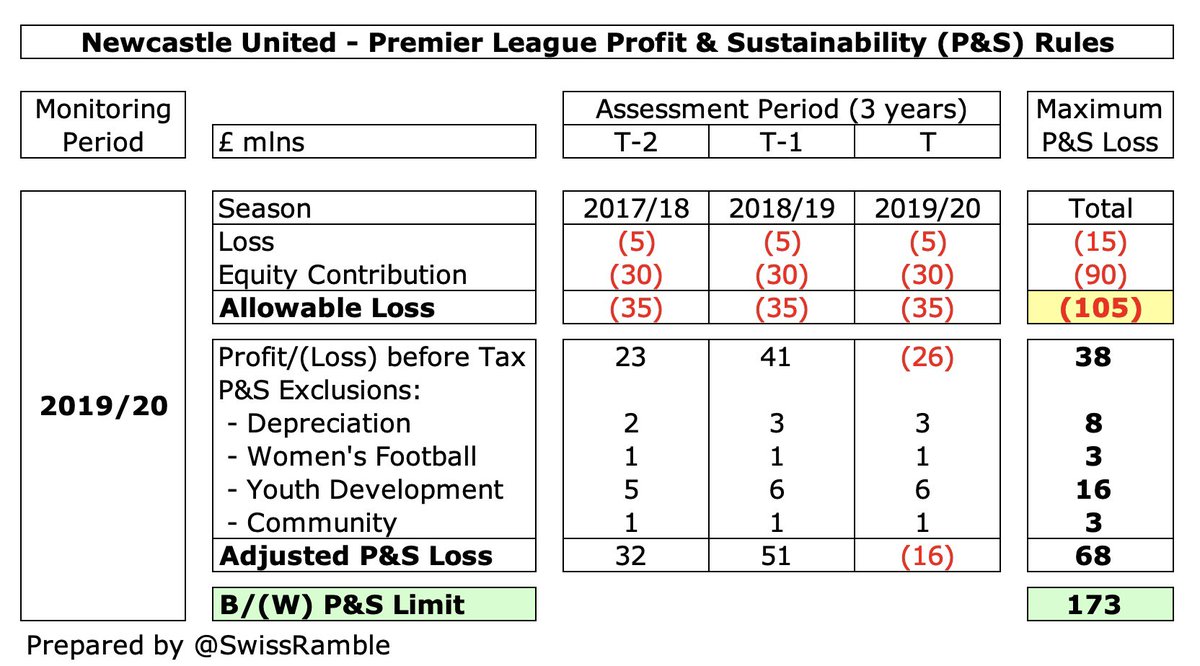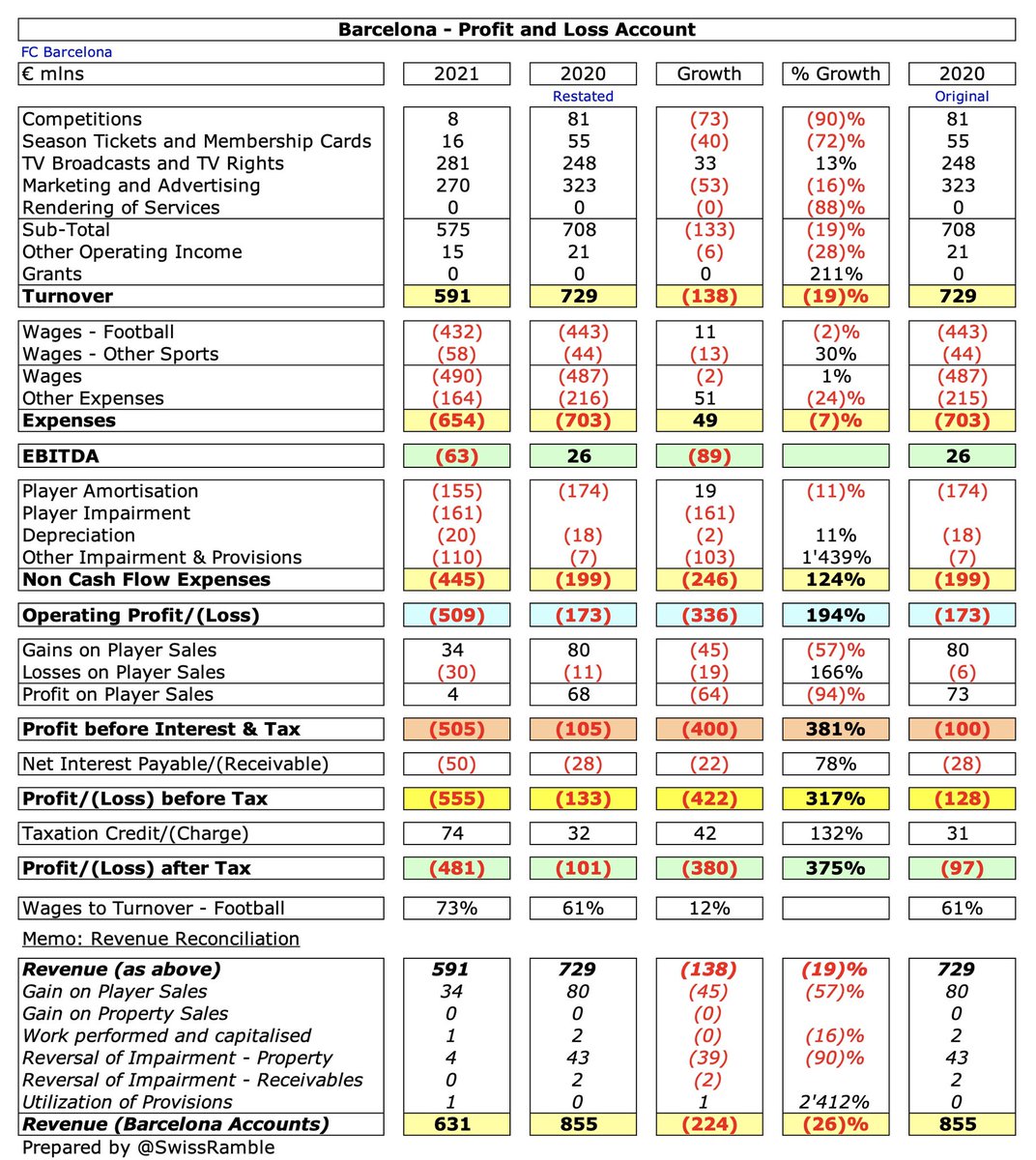
Manchester United have announced their financial results for Q1 of 2021/22, incorporating the first 3 months of the season, which cover July to September 2021, so includes the return of fans to the stadium. Some thoughts in the following thread #MUFC
#MUFC pre-tax loss improved from £27m to £20m (£16m after tax), as revenue increased £17m (16%) from £109m to £126m and player sales swung from £13m loss to £17m profit, though expenses up £31m (25%). Operational improvement offset by interest payable rising £10m (forex losses). 

The main driver of the #MUFC £17m revenue increase was match day, which rose £17m from £2m to £19m, though commercial was also up £4m (8%) from £60m to £64m. In contrast, broadcasting fell £5m (9%) from £48m to £43m. 

#MUFC wages rose £17m (23%) from £72m to £89m, while player amortisation also grew £4m (13%) from £30m to £34m. Increased business activity, due to home games being played with fans and Old Trafford Megastore re-opening, meant £11m (65%) higher other expenses.
#MUFC interest went from zero in Q1 2021 to £10m net payable in Q1 2022, largely due to an unfavourable swing in unrealised foreign exchange movements on the club’s debt, which is denominated in USD, compared to a favourable swing prior year. 

This is the second year in a row that #MUFC have reported a pre-tax loss in Q1, even though it was lower in 2021/22. It is worth noting that last season’s £27m loss in Q1 ultimately became a £24m loss for the full year. 

#MUFC profit from player sales was £17m in Q1, thanks to the sale of Dan James to #LUFC and a sell-on fee from Romelu Lukaku’s transfer from Inter to #CFC. This is not that big by Premier League standards, but represents a solid improvement from prior year £13m loss. 

#MUFC have reported operating losses for the past two seasons, so it is no surprise to see another deficit in Q1, especially as the club tends to lose money in the first quarter. However, the £28m operating loss in Q1 2021/22 is the highest made for this period. 

Although it is clearly good news that #MUFC revenue increased from £109m to £126m in Q1, it has still not returned to the £135m level pre-pandemic. This suggests that United are unlikely to reach the 2019 peak of £627m (though much will depend on Champions League progress). 

#MUFC match day revenue increased from less than £2m to £19m, as all home games were played in front of a full capacity crowd, while they were all behind closed doors in the prior year. As annual income is usually above £110m, United lost more than most from COVID restrictions. 

#MUFC broadcasting revenue fell £5m (9%) from £48m to £43m, as prior year accounts benefited from revenue deferred from 2019/20 with 6 games played after end-June accounting close. Partly offset by 2 Champions League games this year against 3 Europa League games last year. 

#MUFC commercial income up £4m (8%) to £64m, due to retail and merchandising rising by £5m (9%) to £28m, thanks to “increased Megastore footfall” (aided by the Ronaldo factor), though sponsorship dipped slightly to £36m. No pre-season tour possible. Still below 2020 Q1 £80m peak. 

The #MUFC Q1 figures still include revenue from the highly lucrative £64m Chevrolet shirt sponsorship, as the contract was extended by 6 months to December 2021. However, this will be replaced in January by TeamViewer £47m, which is much lower than the current deal. 

#MUFC wage bill rose £17m (23%) from £72m to £89m, partly due to investment in the squad, though only Jadon Sancho was there for the full 3 months in Q1. Raphael Varane signed mid-August, while Ronaldo only arrived in September (though is the highest paid player in PL history). 

#MUFC estimate that their wage bill will rise by “around 20%” this season, as a result of signing Ronaldo, Varane and Sancho. That would imply a £65m increase to £387m in 2022, which would be the highest ever in England, around the same level as Barcelona in 2020.
#MUFC player amortisation, the annual charge to expense transfer fees over the length of a player’s contract, rose £4m (13%) from £30m to £34m in Q1. This expense had been steadily declining since the £137m annual high in 2018. 

#MUFC £141m gross transfer spend in Q1 2021/22 was more than the £116m outlay in the whole of 2020/21, though not as high as some other years, e.g. £243m in 2017/18. Net spend in Q1 was £112m. United’s gross spend since 2014 is just under £1.5 bln. 

#MUFC Q1 net debt largely flat at £440m, compared to prior year, but has increased by £20m in the last 3 months, as gross debt rose £8m to £538m and cash fell £12m to £99m. US Dollar denominated borrowings unchanged, but higher in GBP terms, due to foreign exchange losses. 

After 3 successive years of reductions, #MUFC transfer payables increased from £136m to £208m, though not as high as £258m 4 years ago, while net transfer debt rose from £93m to £145m. So this summer’s purchases were largely funded by debt, i.e. paying transfers in instalments. 

#MUFC Q1 cash balance of £99m is £40m higher than prior year’s £59m, though it has reduced from (very high) £308m in 2019. It is also much lower than the balances in other first quarters (2018 £216m, 2019 £248m and 2020 £140m). 

After adding back non-cash items and working capital movements, #MUFC had £72m operating cash flow in Q1, but then spent £61m on players (purchases £72m, sales £11m), dividends £11m, interest £8m, capex £4m, loans £416k and tax £335k. Net cash outflow was £12m. 

Although it has fallen from its peak, #MUFC annual interest payment of about £20m is a lot higher than every other Premier League club. In Q1 2021/22 United paid £8m, around the same as previous years. 

#MUFC have found enough cash to pay shareholders (mainly the Glazers) an £11m dividend in Q1, delayed from 2020/21. Another semi-annual dividend will be paid on 7 January 2022. United are the only Premier League club to pay meaningful dividends (£133m since 2016). 

Despite the loss, Ed Woodward said, “These results demonstrate our resilience through the pandemic.” That’s fair comment, though #MUFC debt remains high and wages are shooting up. The outgoing Executive Vice Chairman also argued, “Our top priority remains success on the pitch.”
• • •
Missing some Tweet in this thread? You can try to
force a refresh



